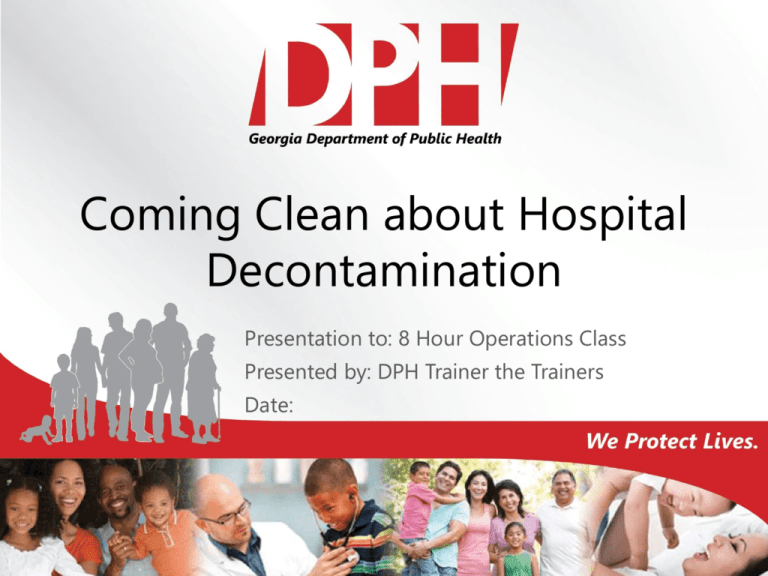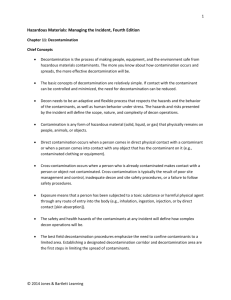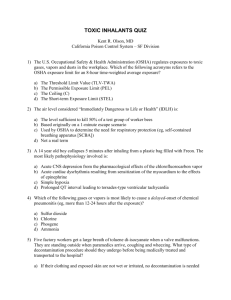Coming Clean About Hospital Decontamination
advertisement

Coming Clean about Hospital Decontamination Presentation to: 8 Hour Operations Class Presented by: DPH Trainer the Trainers Date: Question 1: During decon, hospitals must make an attempt to capture and retain as much runoff from victim and/or mass casualty decontamination operations as possible to comply with EPA and other environmental laws. Reality Myth The Facts • Protecting the environment should NEVER be considered ahead of protecting people. • Contaminated people cannot have enough chemical on them to seriously harm the environment. • The perceived liability cause by potential environmental damage is FICTION. Liability from delaying decon of victim is a FACT. • The EPA agrees: The victims come first! • “First Responders’ Environmental Liability Due to Mass Casualty Decontamination Runoff” (Chemical Safety ALERT July 2000) Question 2: • OSHA requires that hospital decon teams learn and know how to use the DOT ERG. • This Guide will provide useful information to help the decon control officer in selecting proper PPE and determining specific hazards. Reality Myth The Facts • It provides absolutely no useful chemical information to determine proper hospital MCI decon. • It provides no accurate information to suggest the correct PPE for hospital decon operations. • It provides no specific chemical properties. • It was developed only to aid 1st responders in quickly identifying hazardous materials and protecting themselves and the public during the INITIAL response phase of a hazardous materials incident. Question 3: • Water should not be used on people who are contaminated with almost all of the Class 4 water-reactive substances. • Hospitals should have a plan for dry victim decon or should use water sparingly to avoid contact with the substance on skin. Reality Myth The Facts • Water should be used for water-reactive materials, but only low pressure, high-volume. • Garden hoses do not apply “copious” amounts of water and can result in dangerous reactions. • Dry decontamination of victims and responders increases the dangers of the contamination. • Every fire department in the USA has one or more “decon units” (pumpers/engines). Question 4: Oxidizers and Organic Peroxides should be quickly washed from the shoes and clothing of contaminated victims because there is a chance the victim’s clothing could spontaneously ignite at any time. Reality Myth The Facts • Organic Peroxides may have a Maximum Safe Storage Temperature (MSST) or Self Accelerating Decomposition Temperature (SADT), causing them to react with heat. • Many Oxidizers will self-ignite when they dry out on clothing. • Both classes like to decompose when contaminated with organics, acids, etc. • If you make contaminated victims wait for decon, you may place them in great danger. Question 5: • A MSDS provides accurate information to hospitals for decontamination, PPE, and medical care to victims contaminated with a known substance. • The MSDS also provides specific information for medical treatment. Reality Myth The Facts • Material Safety Data Sheets rarely provide accurate information about victim decontamination or medical care beyond first aid. • The MSDS for the same chemical differ between the manufacturers. • MSDS’s mostly say use copious amounts of water to wash product off the skin/eyes. Question 6: • Victim decontamination should never be delayed while determining the proper soap or other additives. • The rapid use of low pressure high volume water and quick disrobing are the best decon solutions. Reality Myth The Facts • Initial decon operations don’t require soap or additives to remove most chemicals. • “Additives” or decon-solutions may cause reactions if used without professional advice. • Brushes of any kind are not recommended nor required to decontaminate the skin. • Soap dilutes quickly in decon buckets. • After a few victims, the soap is gone and effectiveness of brushing decreases. Question 7: Cool or cold weather decontamination operations should not be delayed to wait for the decon shower water to be heated or “tepid.” Reality Myth The Facts • Heating decon water is not very practical because it delays decontamination and heaters cannot heat large volumes quickly enough. • Great for secondary decon/personal showers • Cold water is uncomfortable but it does not induce hypothermia when the people are warmed quickly afterwards. • U.S. Army Soldier and Biological Chemical Command (SBCCOM) decon studies concur Question 8: Over 1.6 million people contaminated with a nerve agent could be decontaminated in an Olympic-sized swimming Reality Myth pool before the pool became too contaminated for further decon. The Facts • SBCCOM Cold Weather Decon Study • Assumptions: 3,000,000L pool – Dose Brought into pool by each person GB-100mg or VX-.1mg • Calculation Results… 1,668,000 people for VX or GB • Comments: From the calculations above the resultant number of people that could be put in a pool without exceeding the no effects level has been reduced by 50% to add an additional margin of safety. In summary, for the agents above (GB and VX) approximately 800,000 people could be processed. Question 9: The deluge system replaces the use of internal and external showers during the decontamination process. Reality Myth The Facts • Removal of clothing and gross decontamination reduces the risk but does not eliminate the risk • The triangle from armpits to groin is where the emphasis should be during secondary contamination Question 10: OSHA requires that hospitals establish 3 zones for their decontamination operation (Hot – Warm – Cold) to control people Reality Myth keeping them safer, and avoiding secondary contamination The Facts • OSHA Best Practices for Hospital-Based 1st Receivers (January 2005) B.3.1 page 17 of 91 “OSHA has found it appropriate to define two functional zones during • hospital-based decontamination activities.” These zones, which guide the application of OSHA’s recommendation are: • Hospital Decon Zone: Includes any areas where the type and quantity of hazardous substances is unknown and where contaminated victims, equipment, or waste may be present. This area typically ends at the ED Door • Hospital Post-decontamination Zone: An area considered uncontaminated. Equipment and personnel are not expected to become contaminated in this area. (includes the ED (unless contaminated)). Question 11: Ammonia and Chlorine, two very common industrial chemicals, may cause severe respiratory distress, skin burns, and even death to victims, BUT victim decon is simple because there is Reality very little chance of adverse impacts on either the decon workers or the environment. Myth The Facts • Most gases do not create a hazard for decon workers, even nerve agents. • Chlorine and Ammonia are very corrosive but they off-gas and dissolve in decon water. • Concentrations may be IDLH when the victim is contaminated, but below the Permissible Exposure Limit/Time Weighted Allowance (PEL/TWA) by the time they are in the warm zone at the incident site. • If the victim is still alive the danger to the protected decon worker is usually minimal. Question 12: Reality Myth • Pre-hospital • Removing contaminated decontamination can clothing can reduce the eliminate the risk of quantity of the secondary exposure. contaminant by up to 25% The Facts • Pre-hospital decontamination will limit the risk of secondary exposure, not eliminate it. • Removing clothing will reduce the quantity of the contaminant by 75 % or more. • SBCCOM Mass Casualty Decon Study. Question 13: Clinicians, security officers, triage teams and other hospital staff members who play a role in receiving and treating contaminated patients are considered by OSHA to be 1st Receivers. (same as the hospital’s decon workers). Reality Myth The Facts • OSHA Best Practices for Hospital-Based 1st Receivers (January 2005) A.2 page 8 of 91 • “First Receivers typically include personnel in the following roles: clinicians and other hospital staff who have a role in receiving and treating contaminated victims (e.g. triage, decontamination, medical treatment, and security) and those whose roles support these functions (e.g. set up and patient tracking)” • First Receivers are a subset of First Responders Question 14: OSHA’s Best Practices for Hospital-Based First Receivers does not include/cover infectious outbreaks for which decon is not needed. Reality Myth The Facts • OSHA Best Practices for Hospital-Based 1st Receivers (January 2005) A.2 page 8 of 91 • The scope of this best practices document does not include situations where the hospital (or temporary facility) is the site of the release. Nor does it include infectious outbreaks for which decontamination is not necessary. Question 15: Hospital employees assigned the task of developing the decontamination program, procedures, and PPE selection criteria require additional training beyond the 1st Receiver Operations Level than the hospital decon team members require. Reality Myth The Facts • OSHA Document 3152 (1997) “Hospitals and Community Emergency Response What You Need to Know” Training Employees - 7th page • Individuals who develop the decontamination procedures and select PPE for the workers who help decontaminate patients, must be trained to the First Responder level (changed to First Receiver in 2005) with additional training in decontamination procedures, but such individuals would not need the lengthy specialized training required for a hazardous materials technician. Question 16: When training hospital decon teams, the competencies identified in the OSHA standard for the Reality Myth Operations Level can be deleted or tailored to fit the expected tasks. The Facts • Interpretive Letter 12/2/02 to Capt. Kevin Hayden State of N.M. E.M. Section (page 2) • Generally, all competencies listed in 29 CFR 1910.120 (q) (6) (ii) should be met for hospital employees trained to the First Responder Operations Level designated to decontaminate victims. • Competencies may be tailored to fit the tasks the employees are expected to perform. • For instance, placard recognition is not required as a basic hazard and risk assessment technique. The ability to identify placards is important for a Hazmat Team, but not for hospital personnel designated to perform decontamination. Question 17: OSHA requires Awareness Level training be completed before Operations Level Training begins and Operations training must be at least 8 hours in duration. Reality Myth The Facts • Interpretive Letter 9/24/02 to Scott Cormier HCA Richmond Market Hospitals (page 2) • Question 4- Is a training course that combines the first responder awareness level and first responder operations level competencies in one 8 hour course acceptable? • OSHA’s Reply: “Yes. The statement in the VA letter that a total of 16 hours of training is required for the first responder operations level is not correct.” • I.L. 4/22/03 to Mike Bolt Novant Health states, “If you spend two hours training employees in the required competencies for the Awareness Level, then you would need to spend at least six hours training for the Operations level.” Question 18: OSHA requires that hospitals provide a minimum of 8 hours of annual refresher Reality Myth training for staff trained to the First Receiver Operations Level. The Facts • Interpretive Letter 9/24/02 to Scott Cormier HCA Richmond Market Hospitals (page 2) • Question 5: Is there a minimum competency or hour requirement for refresher training ? • OSHA’s Reply: “No. There is no minimum time specified for emergency response refresher training. The training must be of sufficient content and duration to maintain the competencies for the responder’s level. Alternately, employees may demonstrate those competencies at least annually.” Question 19: • The employer (hospital) is the only one who can certify an employee to any OSHA Hazwoper Level. • A public or private training Reality agency cannot officially certify any employee but Myth their own. The Facts Interpretive Letter 12/2/91 to Richard Andree S&H Mgt. • Consultants Inc. (page 2) • OSHA does not certify individuals, it is the employer who must show by documentation or certification that an employee’s work experienced and/or training meets the requirements of 1910.120. • There must be a written document which clearly identifies the employee, the person certifying the employee and the training and/or past experience which meets the requirements. Interpretive Letter 3/10/99 to Daniel Burke St. John’s Mercy MC. • St. Louis (page 1) • Hazwoper requires the employer to certify that the workers have the training and competencies listed in (q) (6) (ii) Question 20: Clinical hospital staff without 1st Receiver training may enter a contaminated decon zone without any prior 1st Receiver and/or PPE Reality Myth training, if they are deemed “skilled support personnel.” The Facts OSHA Best Practices for Hospital-Based 1st Receivers (January 2005) C.3 page 22 of 91 • • (A) A member of the staff who has not been designated, but is unexpectedly called on to minister to a contaminated victim, or perform other work in the hospital Decontamination Zone, is considered “skilled support personnel.” Examples include a medical specialist or trade person such as an electrician. • These individuals must receive expedient orientation to site operations, immediately prior to providing such services. The orientation must include: • • • • Nature of hazard (if known) Expected duties Appropriate use of PPE Other appropriate safety and health precautions ( e.g. decontamination procedures) Question 21: Federal OSHA is responsible for enforcing 1910.120 “Hazwoper” in private hospitals only, except in OSHA States Reality Myth where Federal OSHA does not enforce OSHA standards. The Facts • Interpretive Letter 12/2/02 to Capt. Kevin Hayden State of N.M. E.M. Section (page 3) • State and municipal employees (e.g. EMS/Fire) are covered by the standard in those states which operate their own Federally approved State OSHA Program. In those states under Federal OSHA , the EPA regulates State and Local employees including volunteers under 40 CFR 311. • Interpretive Letter 12/2/02 to Capt. Kevin Hayden State of N.M. E.M. Section (page 3) • Federal OSHA has no jurisdiction over state and local government employees such as the public employees of a state-owned hospital. Twenty three states operate programs that cover both private and public sector employees. Question 22: While an environment that is immediately dangerous is Reality possible, it is extremely unlikely that a living victim could create an Immediately Dangerous to Life and Health (IDLH) environment at a receiving hospital. Myth The Facts • OSHA Best Practices for Hospital-Based 1st Receivers (January 2005) B.2.1.1 page12 of 100 • The Georgopoulos Study of 2004 determined that 100 grams or 4 ounces of the most moderately to highly volatile substances that might be sprayed on a victim during a MCI would evaporate within 5 minutes from the time the exposure occurred. • Horton Study (2003) agreed stating that substances released as gases or vapor are not likely to pose a secondary contamination risk to 1st Receivers. Limited exposure may be possible. • Quote: “It is extremely unlikely that a living victim could create and Immediately Dangerous to Life (IDLH) environment at a receiving hospital, particularly if contaminated clothing is quickly removed and isolated and the victim is treated and decontaminated in an area with adequate ventilation.” Question 23: OSHA Hazwoper requires hospitals to conduct basic pre-entry medical surveillance for decon workers and those who use chemical protective clothing and respirators Reality before they begin work in their PPE. Myth The Facts NFPA 471 is only a standard and does not require medical assessment before entry. OSHA 1910.120 (f) Requires the following medical surveillance for hazmat team members: Prior to assignment and upon termination or reassignment Once every 12 months or 2 years if physician deems appropriate If they exhibit signs or symptoms, injure, or exposed above Permissible Exposure Limits (PEL) Physician may require more frequent medical surveillance Question 24: Because Hazwoper is a “performance-based” regulation hospitals are allowed flexibility in meeting the requirements. They are Reality Myth not required to follow any specific procedures or guidelines in OSHA 1910.120. The Facts • OSHA Document 3152 (1997) “Hospitals and Community Emergency Response What You Need to Know” Training Employees 7th page: • Hazwoper is a performance-based regulation allowing individual employers flexibility in meeting the requirements of the regulation in the most cost-effective manner. • There are numerous examples of this decision in many Interpretive Letters. Question and Comments






